Expanded polystyrene for underfloor heating: an overview of heaters and their installation options
Thermal insulation is one of the important components of underfloor heating systems, which allows rational use of energy. An insulating layer is needed to reduce the load on the heating equipment and to maintain the obtained micro-climatic parameters. It prevents the leakage of heat through the ceiling in unheated zones, sets the necessary direction of the heat flow. Polystyrene foam copes with the above tasks best of all known heaters: for a warm floor, it is a universally recognized optimal option.
The well-known technical term "polystyrene foam" combines several varieties of thermal insulation products. They differ in characteristics, applications and installation methods. Information about the differences will help determine what is best to buy for the arrangement of an underfloor heating system with specific technical data.
Content
Expanded polystyrene foam and its competitors
Of the heaters currently used in construction, almost all are applicable for the arrangement of underfloor heating systems. However, there are reservations that stop the desire of professional and independent builders to buy and stack:
- cork insulation, the price of which suggests the search for a more affordable alternative;
- mineral wool, too sensitive to the action of groundwater, which is why it is highly undesirable to use it in floor constructions on the ground and over unheated underground;
- foamed polyethylene with or without a foil sheath - a material that is three times smaller in thickness under the weight of the screed;
- granular and extruded polystyrene foam, attracting with cost and insulating qualities, but not possessing sufficient rigidity.
Note that granular and pressed polystyrene foam for a warm floor is a material quite suitable if it is not intended to distribute the load on it. Those. it’s cheaper and more practical to find nothing for the installation of heating equipment in the construction of a wooden floor with logs and a cold floor.
In general terms, the scheme for constructing a warm floor with foam or loose polystyrene insulation will look like this:
- Polystyrene granules or cut foam boards fill the free space between the logs installed on a plank or plywood base.
- On top of the insulation, it is covered with a vapor barrier membrane, then an additional crate is built into the cross lags to ensure ventilation.
- Plywood or similar sheet material is attached to the crate.
- Install rails from the rails, between which the hinges of the warm floor will fit.
- Further in accordance with the budget. Either a foil of 30 microns thick is laid only along the path of the pipes of the water floors or the electric cable, or it is completely covered with foil polyethylene. Or between the rails installed metal profiled guides, manufactured specifically for wooden floor heating.
After laying pipes or cable, the structure is blocked by plywood, OSB plates, GVLV sheets according to the rules dry screedand then the coating is laid.By default, we assume that this structure is protected from underground moisture and condensation by waterproofing from the underground or it was already under the board or plywood rough foundation.
Attention. Despite the assurances of most manufacturers that the foam and granular styrene are immune to moisture, waterproofing is imperative. Otherwise, moisture that has penetrated into the pores and in the intervals between the granules will significantly reduce the insulating properties of the heaters.
It is very advisable to protect the material from the basement with a fine metal mesh from rodents. Polystyrene does not cause appetite, but they should not be given the opportunity for tasting.
A special reflective substrate contributes to an even distribution of heat on the floor surface, and also actually accelerates the heating of the system. It is very important to choose the right material for different systems. We will help you figure it out here:https://floor.techinfus.com/en/tepliy-pol/podlozhka-pod-teplyj-pol.html.
Technical and technological advantages of expanded polystyrene
Foamed polystyrene differs from its insulation counterparts in increased density, strength and rigidity, which is due to the manufacturing method.
Production steps to simplify:
- Polystyrene or one of its derivatives according to the name of the future product is foamed by introducing a low boiling liquid into the initial mass.
- As a result of boiling, granules clad with a waterproof styrene surface are formed. Inside the granules is a gas that determines the lightness and insulating properties of the material.
- "Semi-finished product" is heated with steam to increase small grains in 10 and even 30 times the size.
- Then, the enlarged granules are sintered between themselves and form insulation boards with small, but very strong numerous cells.
The technical data of the product depends on the sintering method. Sintering suspensions, press equipment, extruders, autoclaves are used to connect the individual components into a heat-insulating product. In construction, extruded polystyrene is the most popular, it is suitable not only for the installation of a warm floor, but also for insulation of basement floors, for thermal insulation of basements, walls. True, it is rarely used as a heater of interfloor ceilings. Most often, structures between floors are equipped with foamed polyethylene or cork. After all, they are thinner and special optimization of heat engineering is not required there.
Extruded foamed insulation is offered to the consumer in numerous multi-colored variations, the coloring of which depends on the preferences of the manufacturer and does not affect the scope of application. You can stack it:
- on the ground with preliminary tamping, backfilling with crushed stone and 10 centimeter sand preparation;
- on a concrete floor covered with a 0.2 mm polyethylene layer;
- on wooden beams coated with polyethylene or glassine.
note. The use of insulating bitumen mastics, materials containing solvents is prohibited. They destroy the structure and dissolve polystyrene foam.
Stiff polystyrene boards can even be laid on compacted gravel. The main thing is not to forget that in any case, the insulation must be protected from moisture and cut off from the walls in order to interrupt the transfer of heat and sound vibrations.
Most rooms have a practical and durable concrete floor, but it is cold. To save energy and money, it must be insulated. We will tell you how to do this in our review of installation technologies:https://floor.techinfus.com/en/tepliy-pol/uteplenie-betonnogo-pola.html.
Specificity of foil insulation
The use of expanded polystyrene plates in underfloor heating systems requires refinement by means of marking, installation of rails, the selection of fasteners and the need for foil. It is laid over thermal insulation.The purpose of using the foil is to screen energy and to evenly distribute heat along the entire perimeter, otherwise the warm floor will work with the effect of "zebra". Those. around heat transfer pipes or around the cable the temperature will be higher, and in the gaps between the heat-conducting components less.
To reduce the number of technological processes, plate polystyrene foam was deliberately equipped with a useful aluminum layer. We also thought about it and marked it on the surface to facilitate the laying of pipes or cables with a snake, snail, etc., so that it would not be necessary to install a grid for heating loops. Then the plates were supplemented with a ruler and a dock fold. And some were divided into strips with a common foil base, so that you can collapse, expand and easily transfer.
In general, they tried to ease the worker's everyday life as they could. They invented foil adhesive tape for fastening plates, clamps and clips for heat conductors, and plastic guides for convenient laying of loops. The result was a lot of options for individual components and ready-made sets of foil polystyrene foam, so that for a warm floor you can find a product that perfectly matches the level of the master, his desire to work hard, be smart and comply with technical requirements.
However, all the shortcomings have not been eliminated. Foil insulation for underfloor heating must be covered with plastic wrap. Otherwise, polystyrene foam insulation will quickly corrode the screed on top of concrete or cement-sand mortar.
Expanded polystyrene plates with bosses
The achievements described above did not allow the developers to run dry. The invention of plates with preformed bosses helped to completely abandon nets, markings and guides. The list of advantages of these plates:
- increased density and, as a result, higher mechanical strength;
- the presence of a vapor barrier of hard polystyrene that protects against condensation;
- lamination of a foil against chemical aggression of a coupler;
- bosses that facilitate the laying of loops in accordance with any technological "ornament";
- light weight, which the stacker likes and slightly loads the base;
- side locks, thanks to which it is possible to build a monolithic heat-insulating carpet without acoustic seams and cold bridges;
- embossed inside, providing ventilation, easy smoothing of small irregularities, protecting the ears of neighbors from the murmur of a working system.
Polystyrene foam with lugs, designed for quick installation of a warm floor, does not shrink under a heavy screed, but in the linear direction some changes in geometry are not excluded.
Important. Any type of thermal insulation for a heated floor in a concrete screed is constructed in compliance with the deformation gap around the perimeter. We also need expansion joints, which in residential premises are more convenient to arrange in the doorway.
The material does not emit toxins harmful to users if it is not heated to 180 ° C, which is unlikely to happen. Without consequences, short-term heatings up to 110º pass. Hosts that comply with the operating conditions will use a floor with polystyrene foam insulation for at least 50 years.
The stacker of plates with bosses will need to start from the corner farthest from the door. The floor elements are arranged according to the principle of brickwork, i.e. with the displacement of the butt seam of the next row relative to this landmark of the previous row.
You can read more about various materials for floor insulation in our special article:https://floor.techinfus.com/en/tepliy-pol/teploizolyaciya-dlya-teplogo-pola.html. Overview of insulation and tests of various substrates.
Work algorithm:
- The prepared concrete base is covered with a layer of polyethylene. We lay it with an overlap of 10 cm, we fix the individual components with construction tape.
- We fix the damper tape to the walls in one layer. To facilitate the process on its back side there is an adhesive strip.
- In the doorway, we establish a strip of two sections of the damper tape that are deployed to each other with the rear. They stick together thanks to the aforementioned adhesive strip.
- We stack the first row, as expected, with deformational indents from the walls.
- We trim the last panel in the row according to the situation.
- From the obtained section of the panel, we begin the next row.
Before pouring screeds on top of the cable or pipes, waterproofing is no longer necessary, because most plates have a protective surface of dacron.
Which material and styling scheme to choose, the contractor will be prompted by a desire to make an effort or to shell out money. Naturally, an improved insulation will cost more, but preparing the floor for laying pipes or cable will not make you strain and lose time. Economical and diligent craftsmen should show their best sides and use extruded polystyrene foam without marking, foil, rebate locks and fasteners.

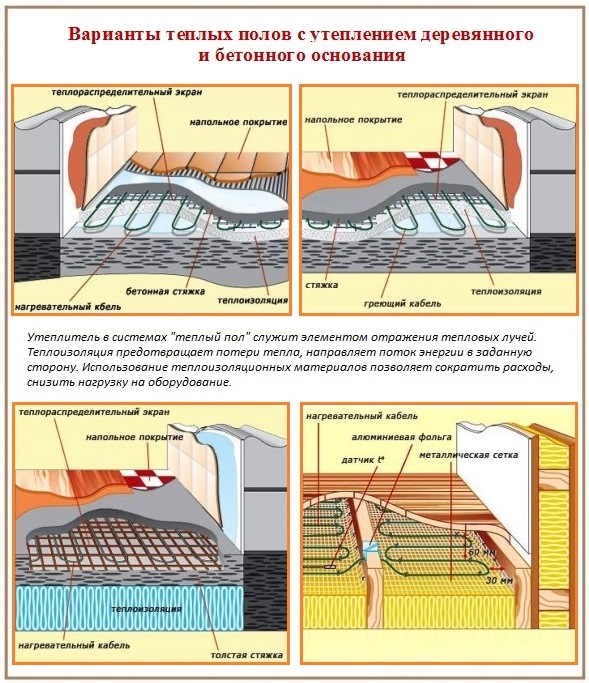
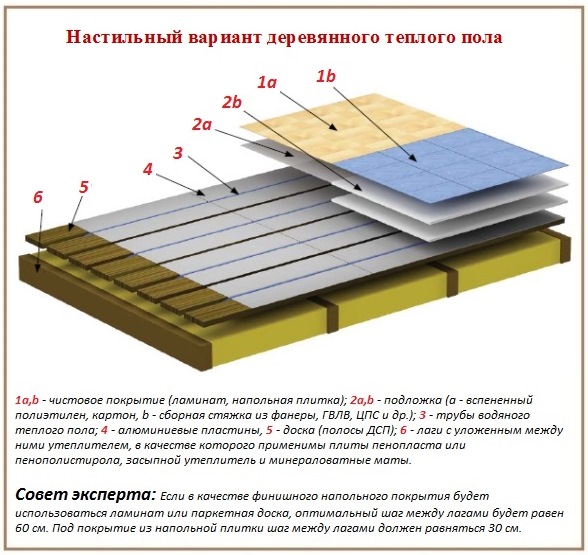
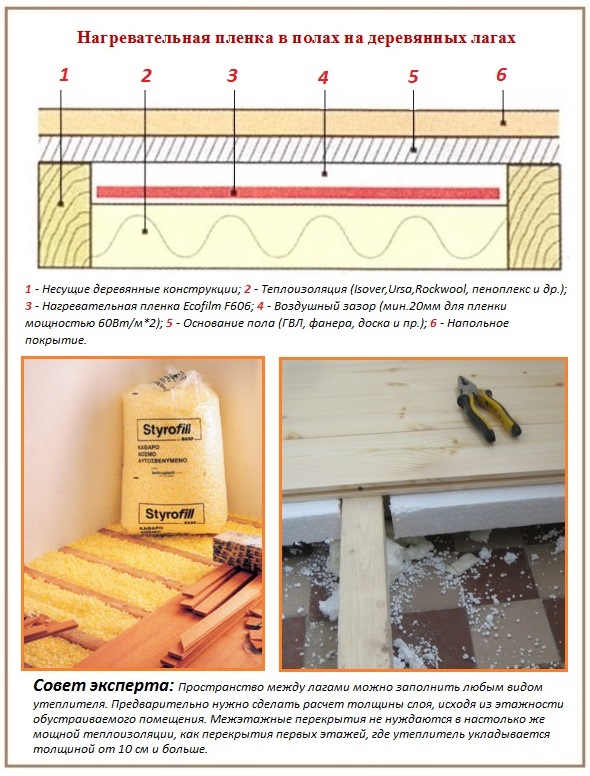
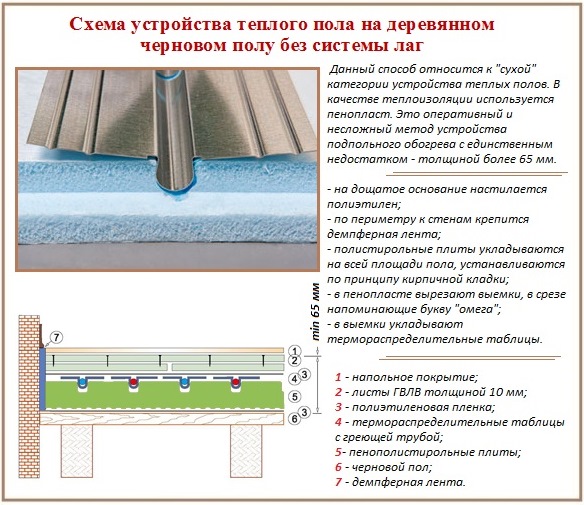
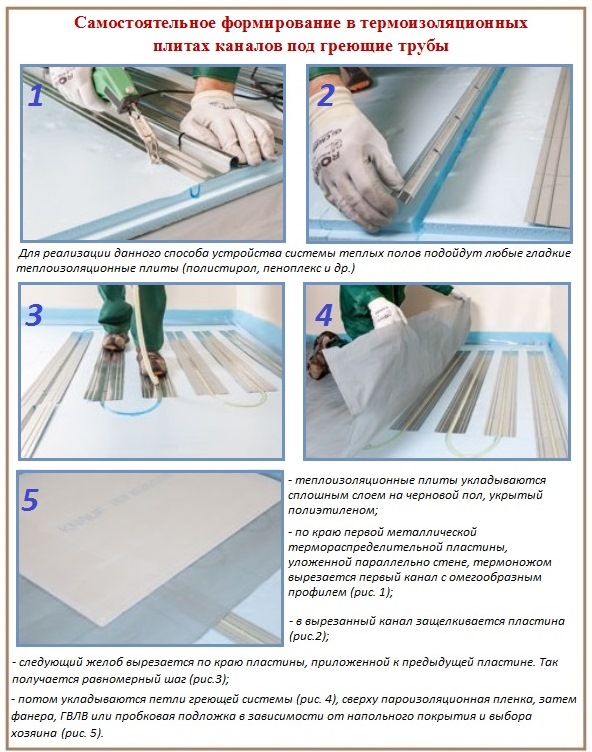
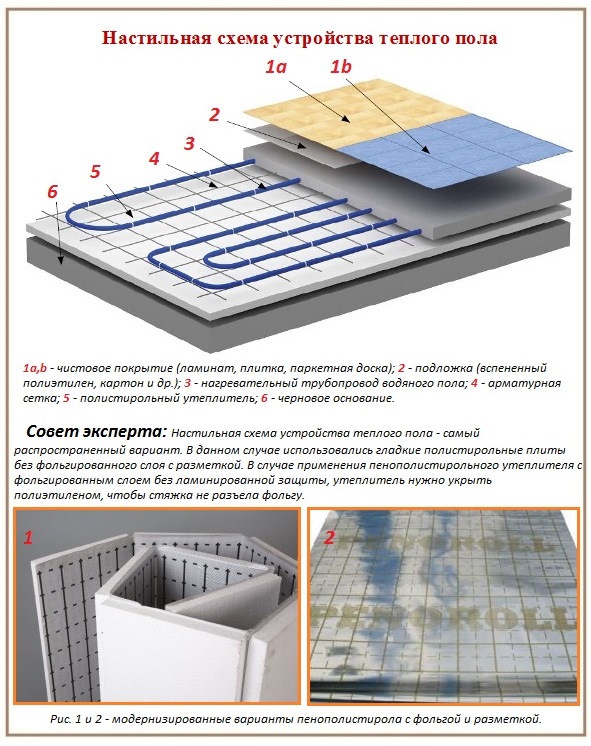
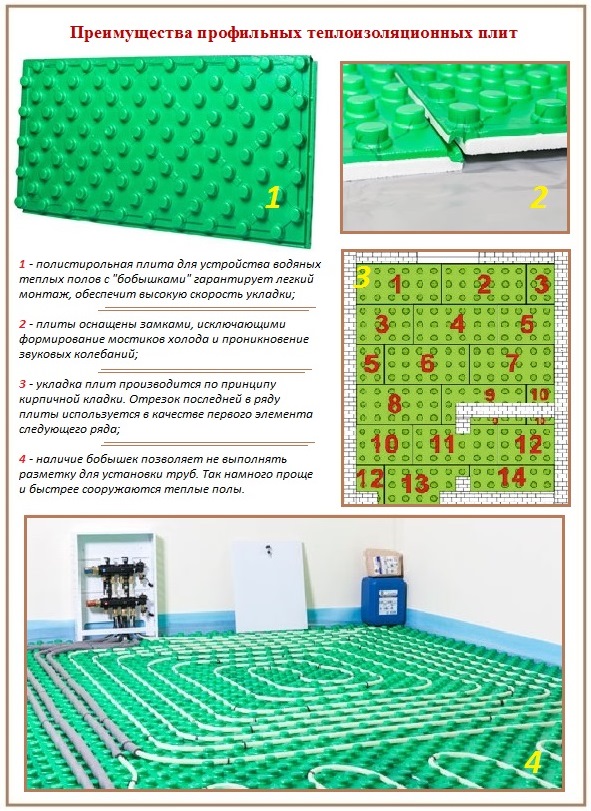
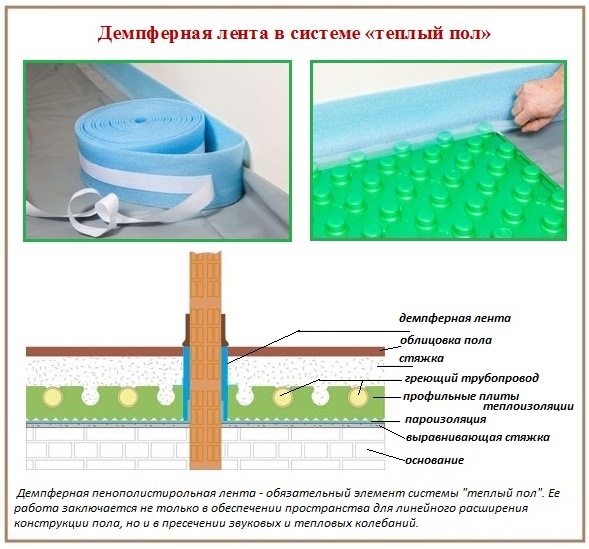
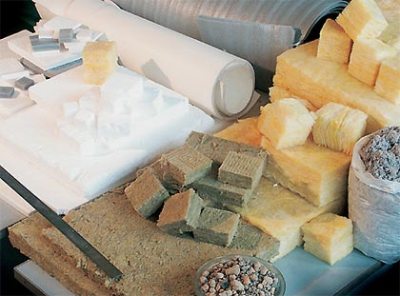
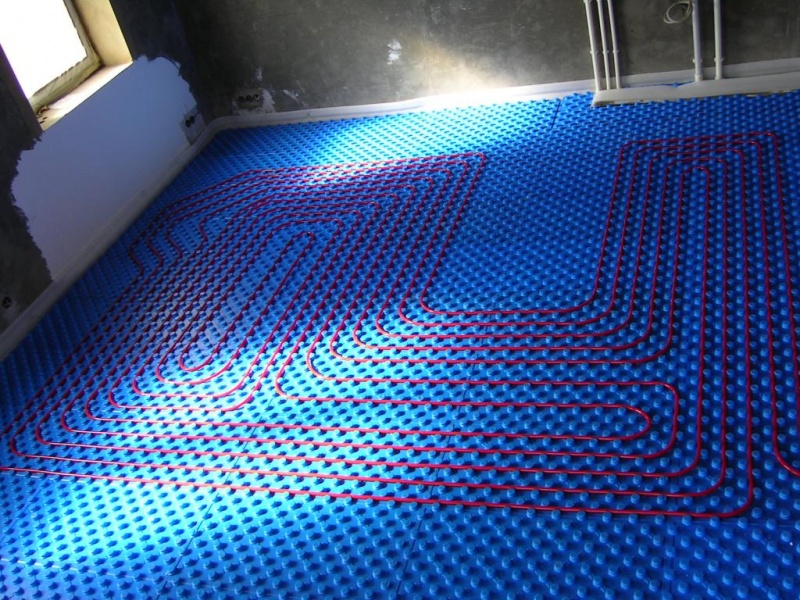
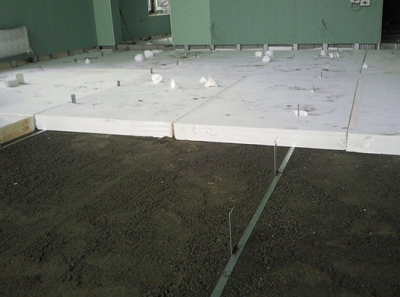
5 comments